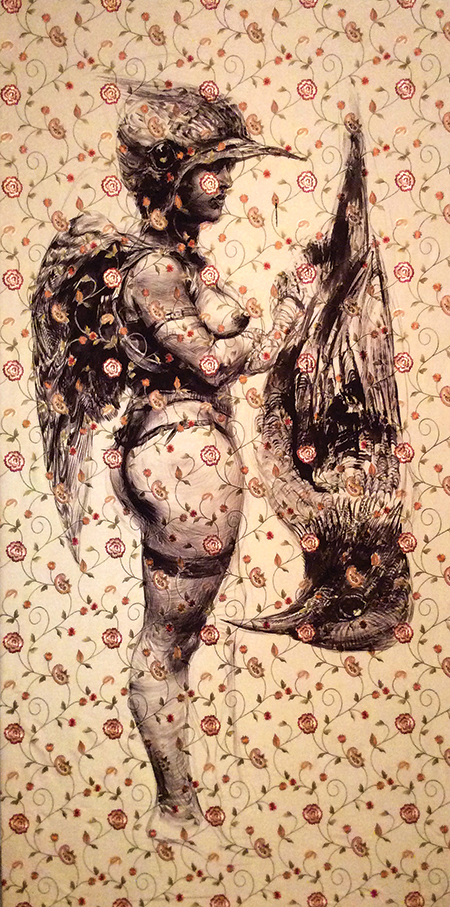
Continuing through October 18, 2014
Though he's internationally known in a career spanning five decades, most of us have never heard of Roberto Fabelo for a good reason. His exhibit continuing at the Museum of Latin American Art is his first solo museum show in the United States, and the show of new work at Couturier his first gallery exhibition here. I guarantee this, however; if you take a trip to Long Beach to see "Fabelo's Anatomy” or to see the recent work in Los Angeles you will never, ever forget this artist. Not only does his playful imagery evoke Gabriel Garcia Marquez's magical realism and the surreal world of Hieronymus Bosch — executed with the craftsmanship of Dutch/Flemish masters — it is also humorous in its comedic treatment of human desire. In fact, the term "Kafka-esque" might spring to mind; and that's no joke.
On view at the museum are a series of large paintings that depict voluptuous, female nudes — all of them wearing high heels. Sometimes they have wings and assorted bird masks; sometimes they ride on the back of giant roosters (i.e., "Fantastic Voyage to Key West" and "Giant Blue Rooster"); other times they reference sea creatures, have fish-masks or mermaid tails; and are positioned in the water. In "Baroque Seafront” the nudes are depicted as conches, mermaids, fish, turtles, etc.
Titles are often evocative, such as "Women of One Hundred Years of Solitude” (a direct reference to Marquez' masterpiece), "Women of the Night" (nine black and white voluptuous nudes lined up in a row) or "Pink Mermaid" (a gigantic soup bowl full of nude mermaids in shell head-dresses, plus a pink one near the bowl's brim). While some of the figures are painted on canvas or drawn on paper, others are rendered on silk with embroidered flowers, which create an all-over pattern that interacts with the painting.
A second example of Fabelo's creative imagination will also captivate your attention in both shows. A lengthy series of intricate ink drawings on appropriated pages from Leo Testut’s classic four volume "Traité d’anatomie humane” (1893) are each so clever as to deserve to be studied individually and up close. Together they form a fantastic interpretation of the human body that far surpasses any theories that were developed ages ago when the book was first published.
Just as the museum exhibit draws to a close, the other show of Fabelo's work opens. It features new paintings, drawings, and sculpture that extends the allegorical imagery and serious, sociopolitical thought that underlies each hybrid or mythological figure. He continues to favor the semi-nude female figure, at times seemingly as an excuse to draw their breasts. Fabelo drew signifiant attention at the first Havana Biennale back in 1984 for a series of rough cut drawings on kraft paper, “Fragmentos Vitales," that he pasted direct to the wall, an act of arrogant informality that simultaneously dramatized his skills as a draftsman and provided him with avant-garde credentials.
Thirty years on, given the trajectory traced in the MoLAA survey that lands us into the elegant but not unsurprising work at Couturier revealed prior to publication only in part, the contemporary audacity is rooted in the Old Religion, and the mythological creatures full of that magic are constantly exposed as real women. Wings are attached not natural, strapped on tight enough for us to feel discomfort that does not register in the figures’ detached, averted expressions. Animals regularly continue to appear, particularly birds, in a variety of roles from stand-in for a male sex partner to a full biological graft that might have been a storyboard for “A Clockwork Orange.”
Fabelo continues his interest in patterned silk and anatomy book pages as ground, and it seems clear, inspiration for this continual play of pieces that he works interchangeably with a deceptive ease. This is not merely an attribute of an illustrator’s skill, but the manifestation of a receptive mind that gravitates equally between the narrative and the symbolic. If the new works in the gallery show are certain to please the eye with their clarity of invention, it is our expectation, though hardly certain, that the implicit connections among these works will spin some provocative tales.
Published courtesy of ArtSceneCal ©2014
